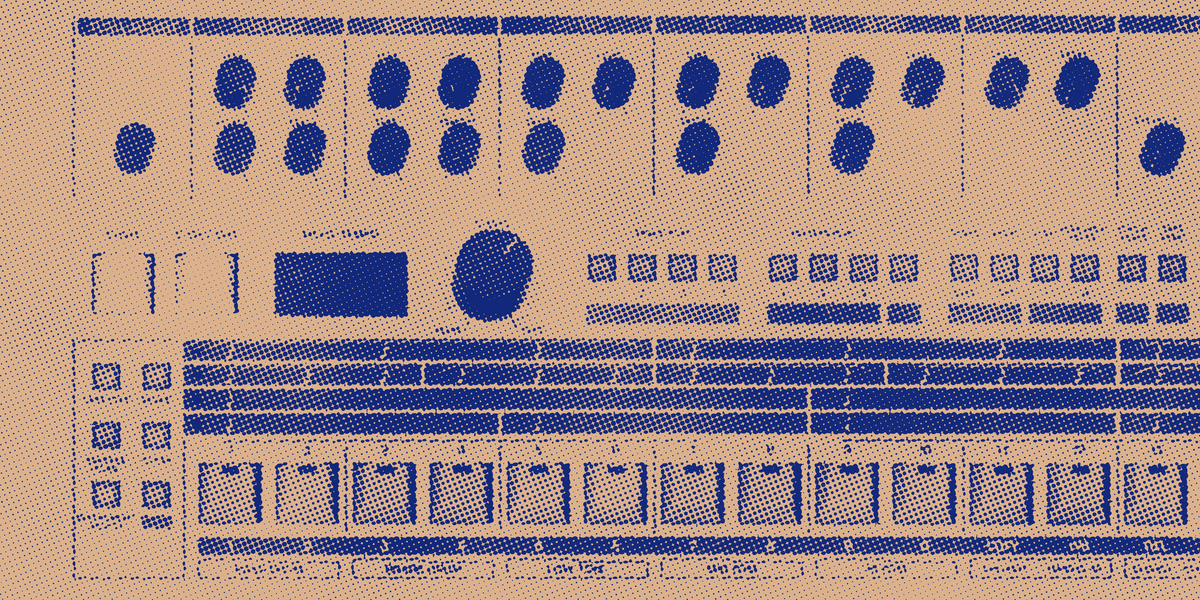The ultimate guide to the Roland TR-909
The most iconic drum machine since the other one Roland made so famous, the TR-909 is a staple of dance music and art in all forms.

In the ever-evolving landscape of music production, certain instruments transcend their original purpose and become iconic symbols of creativity and innovation. One such instrument that has left an indelible mark on the music industry is the legendary Roland TR-909 drum machine. Since its introduction in the 1980s, the TR-909 has not only revolutionized electronic music but also influenced numerous genres across the musical spectrum. Join us on a deep dive into the captivating story of the TR-909, exploring its origins, impact, and the enduring legacy that still resonates today.
Part One: Genesis of a Legend
The Visionaries
At the heart of the Roland TR-909's creation were the visionary minds of Ikutaro Kakehashi and the dedicated team at Roland Corporation. With a rich history of electronic instrument innovation, Kakehashi and his team sought to develop a drum machine that would not only emulate realistic drum sounds but also offer a range of creative possibilities for musicians and producers.
Ikutaro Kakehashi was a visionary and pioneering figure in the music industry, known for his significant contributions to electronic instrument design and manufacturing. Born on February 7, 1930, in Osaka, Japan, Kakehashi displayed a passion for music from a young age. His journey began with repairing and building electrical equipment, leading him to establish his own company, Ace Electronic, in 1960.
In 1972, Kakehashi founded Roland Corporation, a company that would revolutionize the music industry with its innovative electronic instruments. Under his leadership, Roland became synonymous with cutting-edge technology and groundbreaking products. Kakehashi's philosophy was centered on empowering musicians by providing them with accessible and reliable tools to express their creativity.
Kakehashi's role in the creation of the Roland TR-909 drum machine was pivotal. Alongside a dedicated team of engineers and designers, he spearheaded the development of the TR-909, driven by a vision to create a drum machine that would offer realistic and versatile drum sounds. The TR-909 represented a significant leap forward in drum machine technology, combining analog sound synthesis and drum modeling techniques to produce a wide range of drum sounds with exceptional accuracy and depth.
Kakehashi's relentless pursuit of innovation and attention to detail resulted in the TR-909's distinctive features and capabilities. His commitment to quality craftsmanship and the desire to push the boundaries of electronic music production were reflected in the TR-909's user-friendly interface, intuitive controls, and robust build.
Beyond the TR-909, Kakehashi's influence extended to other groundbreaking instruments, including the Roland TR-808 drum machine and the MIDI (Musical Instrument Digital Interface) standard, which revolutionized electronic music by enabling communication between various musical instruments and devices.
Ikutaro Kakehashi's contributions to the music industry were recognized and honored throughout his lifetime. He received numerous accolades, including induction into the National Inventors Hall of Fame in the United States and the Technical Grammy Award in 2013 for his pioneering work in MIDI technology.
Kakehashi's legacy continues to resonate in the music world. His innovative spirit, dedication to musicians, and groundbreaking contributions to electronic instrument design have left an indelible mark. The TR-909 stands as a testament to his visionary approach and enduring impact on the evolution of music production.
Pioneering Technology
The TR-909 introduced a host of groundbreaking features and technical advancements that set it apart from its predecessors. Roland incorporated analog sound synthesis and drum modeling techniques, allowing the TR-909 to produce a diverse range of drum sounds, including the iconic kick, snare, hi-hat, and cymbal sounds that would become synonymous with the machine. Its unique capabilities included adjustable tuning, decay, and accent controls, enabling musicians to sculpt and manipulate their drum patterns with precision.
Ikutaro Kakehashi's quest for innovation and his team's technical expertise were instrumental in the development of the Roland TR-909, introducing groundbreaking technology that set it apart from previous drum machines of its time.
Analog Sound Synthesis
One of the TR-909's defining characteristics was its use of analog sound synthesis. Kakehashi and his team employed a combination of analog circuitry and discrete components to generate the drum sounds, resulting in a rich, warm, and organic sonic character. The use of analog synthesis allowed the TR-909 to deliver the distinct punch and texture that became its trademark, setting it apart from the digital sound of other drum machines.
Drum Modeling Techniques
In addition to analog synthesis, the TR-909 incorporated drum modeling techniques. This approach involved carefully analyzing and emulating the characteristics of real drum sounds, allowing the TR-909 to produce remarkably authentic and lifelike drum tones. From the deep and booming kick drum to the sharp and snappy snare, the TR-909's modeling capabilities captured the nuances and dynamics of acoustic drums, giving musicians and producers an unprecedented level of realism.
Versatile Sound Sculpting
The TR-909 provided musicians with extensive sound sculpting options, empowering them to shape and customize their drum sounds. It offered controls for tuning, decay, and accent, allowing users to adjust parameters for individual drum elements. This versatility enabled musicians to create a wide range of drum textures, from sharp and staccato hits to long, sustained tones. The ability to fine-tune each sound component provided a level of expressiveness and creativity that was previously unavailable in drum machines.
Intuitive Interface and Programming
Kakehashi and his team prioritized user-friendliness when designing the TR-909. The machine featured a straightforward and intuitive interface, making it accessible to musicians of various skill levels. Its layout allowed for quick and easy programming of drum patterns, with dedicated buttons and knobs for each drum sound. The interface facilitated real-time adjustments and experimentation, enabling musicians to craft dynamic and evolving rhythms effortlessly.
Built to Last
Another hallmark of the TR-909 was its sturdy construction and reliability. Kakehashi's commitment to quality craftsmanship ensured that the machine could withstand the rigors of studio and live use. The TR-909 was built to last, with robust components and a durable chassis, ensuring that it could accompany musicians on their creative journeys for years to come.
Through their pioneering use of analog sound synthesis, drum modeling techniques, versatile sound sculpting capabilities, and user-friendly interface, Kakehashi and his team pushed the boundaries of what was possible in drum machine technology. The resulting Roland TR-909 not only delivered exceptional sound quality but also offered musicians unprecedented creative freedom, cementing its status as a legendary instrument that continues to shape music production to this day.
The Emergence
When the Roland TR-909 was initially introduced in the early 1980s, it faced a music landscape dominated by acoustic instruments and traditional band setups. As a drum machine, the TR-909 was met with mixed reactions within the music industry. However, its true potential would soon be recognized and embraced by a growing community of forward-thinking musicians and producers.
Electronic Music's Rising Tide
The emergence of electronic music, fueled by the experimental and boundary-pushing artists of the time, provided a fertile ground for the TR-909 to flourish. As artists began to explore new sonic possibilities, they sought tools that could help them break free from the confines of traditional instrumentation. The TR-909 presented an opportunity to create entirely electronic rhythms and beats, opening up a world of musical expression beyond what was achievable with acoustic drums alone.
Genre-Bending Innovation
The TR-909 found early adopters and champions in the emerging genres of house, techno, and hip-hop. These genres were characterized by their embrace of electronic instrumentation, rhythmic experimentation, and a desire to push the boundaries of what defined contemporary music. Artists and producers quickly recognized the TR-909's unique capabilities, utilizing its iconic drum sounds and programming features to craft infectious and groundbreaking tracks.
Sonic Versatility and Adaptability
One of the key factors that contributed to the TR-909's emergence was its versatility. The machine's broad range of drum sounds allowed artists to craft rhythms that spanned genres, from the pounding bass kicks of dance music to the snappy snares and hi-hats of hip-hop. The TR-909's ability to adapt to different musical contexts made it a powerful tool for artists seeking to explore and create their unique sonic identities.
Underground Resonance
The TR-909 gained traction within the underground music scenes, where artists and DJs were seeking to define their sound and connect with audiences in new ways. Clubs and raves became hotbeds for the TR-909's sonic exploration, as DJs embraced the machine's rhythmic capabilities and integrated it into their live performances. The infectious beats and driving energy of the TR-909 became the backbone of many underground club tracks, resonating with audiences and igniting dance floors worldwide.
As word spread of the TR-909's distinctive sound and its potential for creative expression, its popularity grew within niche music communities. The machine's emergence within these scenes laid the foundation for its broader recognition and eventual impact on mainstream music, setting the stage for the TR-909 to become an iconic instrument that would shape the future of electronic music production.
Part Two: Shaping a Sound Revolution
Exploring the Sonic Palette
The Roland TR-909's sonic palette became its defining characteristic. Its meticulously crafted drum sounds, including the deep and punchy kick, the snappy snare, the crisp hi-hats, and the shimmering cymbals, possessed a distinct and unique character. The TR-909's ability to generate these sounds with remarkable accuracy and its inherent flexibility in shaping them allowed musicians and producers to create compelling rhythm tracks that became the backbone of electronic music. The machine's ability to produce analog sounds with a rich and warm quality distinguished it from other drum machines of the time and contributed to its enduring appeal.
An Agent of Change
The TR-909 emerged as a catalyst for musical innovation, birthing new genres and reshaping existing ones. In the realm of dance music, particularly the underground scenes of house and techno, the TR-909's hypnotic beats and infectious grooves became the driving force behind countless anthems. Its rhythmic patterns and syncopated sounds provided the foundation for pulsating club tracks that captivated audiences and ignited dance floors worldwide. Simultaneously, in hip-hop, the TR-909's booming kick and snappy snare became an essential element of the genre's signature sound, solidifying its place in the mainstream consciousness.
Cultural Significance
The Roland TR-909's impact transcends its role as a mere musical instrument, making it a symbol of cultural significance that resonates beyond the realm of music production. Its influence has permeated popular culture, reflecting broader social and technological shifts of the time.
Technological Advancement and the Digital Age
The emergence of the TR-909 coincided with a broader cultural shift towards the digital age and the rise of technology in everyday life. As computers and electronic devices became increasingly prevalent, the TR-909 represented the democratization of music production. It showcased the transformative power of technology in the hands of musicians, empowering them to create previously unimaginable sounds and rhythms.
Redefining Musical Boundaries
The TR-909 played a vital role in redefining the boundaries of music genres and challenging conventional notions of what constituted "real" instruments. It allowed musicians to explore uncharted sonic territories, enabling the fusion of electronic and acoustic elements. The TR-909's iconic drum sounds became an integral part of the sonic landscape in numerous genres, breaking down barriers and reshaping the musical landscape.
Underground Music Movements
The TR-909's impact on underground music movements cannot be overstated. In genres such as house, techno, and hip-hop, the machine's driving beats and infectious rhythms became the heartbeat of burgeoning subcultures. It played a crucial role in the development of underground club scenes, where the TR-909's sounds fueled all-night dance parties and fostered a sense of community. The machine's cultural significance extended beyond the music itself, representing the rebellious spirit and sense of liberation associated with these underground movements.
Aesthetic Iconography
The TR-909's distinctive appearance, with its array of glowing buttons and sleek design, has become an iconic symbol in popular culture. Its sleek, futuristic aesthetic has been featured in album artwork, music videos, and other visual mediums, serving as a visual representation of electronic music and its associated culture. The TR-909's visual presence has helped shape the image of electronic music as forward-thinking, cutting-edge, and technologically driven.
Enduring Influence and Legacy
Even decades after its introduction, the TR-909 continues to inspire and influence contemporary music production. Its distinctive drum sounds and rhythmic capabilities have been emulated and replicated in software plugins, hardware replicas, and digital instruments. The TR-909's cultural significance lies not only in its historical impact but also in its continued relevance and enduring presence in modern music.
The Roland TR-909's cultural significance extends far beyond its technical capabilities. It represents a pivotal moment in the intersection of technology, music, and popular culture. Its influence on musical genres, underground movements, and visual aesthetics cements its place as a cultural icon and a symbol of innovation that continues to inspire artists, shape the music industry, and captivate audiences worldwide.
Part Three: From Obscurity to Prominence
The Decline and Resurgence
After its initial introduction and early success, the Roland TR-909 faced a period of relative obscurity in the 1990s. The advent of digital music production and the rise of software-based drum machines presented new possibilities and capabilities that surpassed the TR-909's analog technology. Many musicians and producers moved away from hardware drum machines in favor of software alternatives, which offered greater flexibility, convenience, and an ever-expanding palette of sounds.
However, the TR-909 experienced a remarkable resurgence in the 2000s. This resurgence was driven by several factors that reignited interest in the iconic drum machine and brought it back into the spotlight.
Nostalgia and Analog Resurgence
As the digital era matured, a wave of nostalgia for the analog sound and tactile experience of hardware instruments began to emerge. Musicians and producers sought the warmth, character, and hands-on control that analog instruments like the TR-909 offered. The renewed appreciation for vintage and classic gear led to a renewed interest in the TR-909's unique sonic qualities.
Revival of Electronic Music
The 2000s saw a resurgence of interest in electronic music, as new subgenres emerged and electronic sounds gained popularity across various genres. The TR-909's distinct drum sounds, particularly its deep kick drum and punchy snare, became sought-after elements in contemporary productions. Artists, both established and emerging, sought to incorporate the TR-909's signature sound into their tracks, contributing to the revival of interest in the instrument.
https://youtu.be/ydCDro4YerYLive Performances and Onstage Presence:
The TR-909's resurgence was also fueled by its newfound prominence in live performances. As electronic music gained mainstream recognition, DJs and live acts began integrating hardware drum machines into their setups. The TR-909's iconic look, with its distinctive layout and glowing buttons, added a visual and interactive element to performances. Its presence on stage became a symbol of authenticity and a connection to the roots of electronic music.
Limited Availability and Collector's Item Status
As demand for the TR-909 increased, the limited supply of original units added to its allure. The scarcity of well-preserved TR-909 drum machines elevated their value in the second-hand market. Collectors and enthusiasts sought out these rare instruments, driving up prices and creating a sense of exclusivity. The TR-909's status as a collector's item further enhanced its mystique and contributed to its resurgence.
The TR-909's decline and subsequent resurgence demonstrated the cyclical nature of musical trends and the enduring appeal of iconic instruments. The combination of nostalgia, a renewed interest in analog gear, the evolving landscape of electronic music, and the TR-909's distinctive sonic characteristics converged to bring the machine back into the spotlight. Its timeless sound and visual presence ensured that the TR-909 would continue to inspire future generations of musicians and producers, firmly securing its place in music history.
Collector's Item
As the TR-909's resurgence took hold, a fascinating phenomenon occurred—the instrument transformed into a sought-after collector's item. Its limited production run and the increasing rarity of well-preserved units contributed to a surge in demand among musicians, collectors, and enthusiasts. The TR-909's status as a cultural icon, combined with its historical significance, propelled prices to astronomical heights in the second-hand market. Owning a TR-909 became a symbol of musical authenticity and a testament to the instrument's enduring impact.
Modern-Day Influence
Despite the advancements in digital technology and the proliferation of software-based production tools, the TR-909 continues to exert its influence on modern music production. Its distinct analog sound, organic feel, and intuitive interface offer a tactile and immersive experience for musicians and producers. Many contemporary artists, spanning various genres, still rely on the TR-909's iconic drum sounds to infuse their music with a sense of timelessness and sonic character. Additionally, the TR-909's integration into hardware and software emulations ensures its accessibility and relevance in today's digital landscape.
The journey of the Roland TR-909 from a period of obscurity to its resurgence and ongoing influence exemplifies the timeless allure of analog instruments and their enduring impact on music production. Its renaissance serves as a testament to the machine's unmatched sonic qualities and its ability to transcend technological advancements. The TR-909's revival not only celebrated its historical significance but also reaffirmed its position as a beloved and influential instrument that continues to shape the soundscape of contemporary music.


